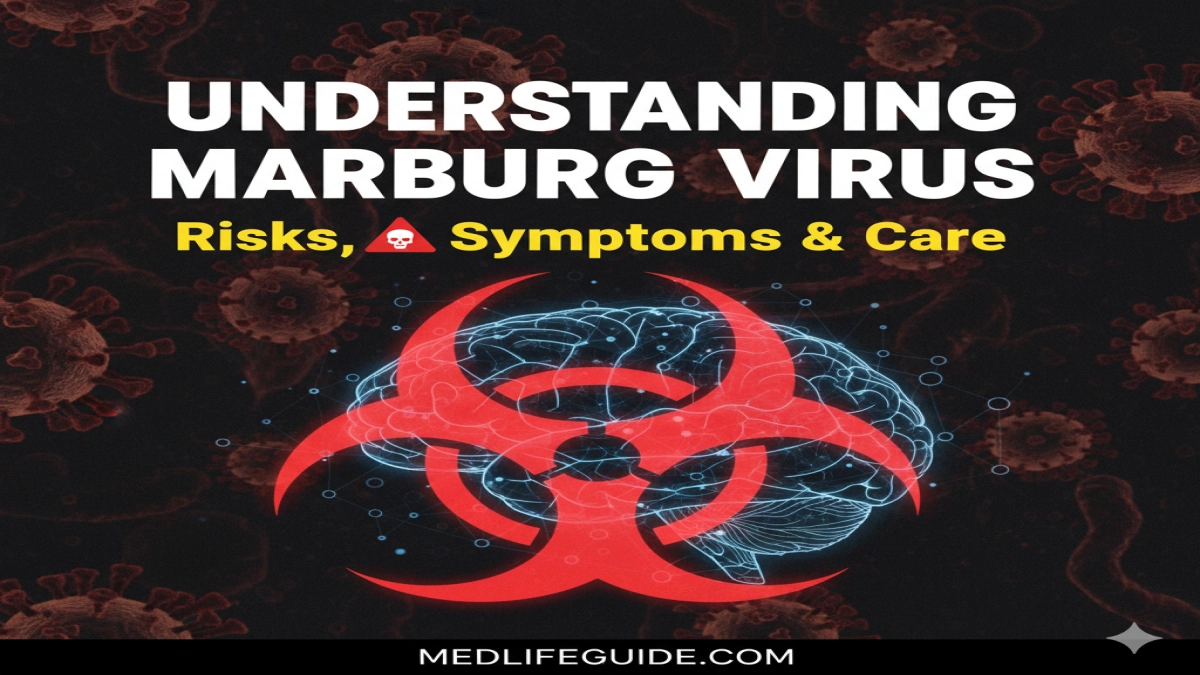Marburg virus disease (MVD), sometimes referred to simply as Marburg, is a rare but extremely serious viral hemorrhagic fever. It’s caused by infection with Marburg virus (or closely related Ravn virus), members of the Filoviridae family — the same family as Ebola.
Because of its high fatality rate, potential for human-to-human transmission, and lack of approved treatments, MVD is considered a major public health concern. What this really means is that while it’s not a common illness, when it does occur, it can be devastating unless identified and managed promptly.
What Is Marburg Virus?
Origin and Virology
- Marburg virus (MARV) and Ravn virus (RAVV) are two closely related viruses that cause Marburg virus disease.
- These viruses are part of the filovirus family.
- The natural reservoir is believed to be fruit bats — specifically the Egyptian rousette bat (Rousettus aegyptiacus).
History
- First identified in 1967, during simultaneous outbreaks in Marburg and Frankfurt, Germany, and in Belgrade, Serbia — linked to infected African green monkeys imported from Uganda.
- Since then, sporadic outbreaks have occurred mainly in sub-Saharan Africa.
Transmission
- Animal-to-human: The virus can spill over from fruit bats to humans.
- Human-to-human: Spread via direct contact with bodily fluids (blood, vomit, urine, saliva, sweat, semen, etc.) of infected people, or via surfaces and materials contaminated with these fluids.
- Persistence in survivors: Virus can remain in some body fluids — for example, semen — for a while after recovery.
- Importantly, Marburg virus is not known to spread by airborne transmission.
Incubation Period & Clinical Symptoms
Incubation
- The time from exposure to the onset of symptoms varies between 2 to 21 days.
Clinical Course
Initial (early) symptoms often resemble flu-like illness:
- High fever, chills, headache, severe malaise, muscle aches.
- As disease progresses (by day 3 or so), gastrointestinal symptoms appear: nausea, vomiting, abdominal pain, diarrhea.
- Non-itchy rash (on torso) may appear between days 2–7.
- From ~day 5, hemorrhagic manifestations can begin: bleeding from gums, nose, venipuncture sites, or in vomit/stool.
- Central nervous system involvement may cause confusion, irritability, aggression.
- In some late cases, orchitis (testicular inflammation) has been reported.
- In fatal cases, death often occurs around day 8–9, typically from severe bleeding and shock.
Diagnosis
Diagnosing Marburg is challenging, especially in early stages, because symptoms overlap with many other diseases (malaria, typhoid fever, other viral hemorrhagic fevers).
Laboratory confirmation requires specialized testing:
- Antibody-capture ELISA
- Antigen-detection assays
- RT-PCR (reverse transcriptase PCR)
- Virus isolation in biosafety level‑4 laboratories
Due to the biohazard risk, samples must be handled under maximum containment conditions and transported in triple packaging.
Treatment & Prevention
- There is no approved antiviral therapy or vaccine for Marburg virus disease as of now.
- The mainstay of care is supportive treatment: intensive fluid rehydration, electrolyte management, symptomatic care.
- Infection control is critical: healthcare workers must use proper personal protective equipment (PPE) and adhere to stringent infection prevention protocols.
- Outbreak control depends on community engagement, contact tracing, safe burial practices, and strong laboratory capacity.
Unique Clinical Takeaways
Here’s what’s less commonly discussed but clinically important about Marburg virus disease:
- Differential Diagnosis Complexity in Endemic Settings
- In regions where Marburg occurs, its early symptoms mimic more common tropical illnesses like malaria, typhoid fever, or even meningitis.
- For health systems with limited lab capacity, delays in distinguishing MVD from endemic diseases can lead to missed diagnoses — and uncontrolled transmission. This underscores the need for syndromic surveillance in high-risk areas, not just during outbreak peaks.
- Risk Factor Nuances: Occupational and Ecological Dimensions
- Miners, spelunkers, or people working in caves or mines (especially where Rousettus bats roost) are at elevated risk.
- But here’s the kicker: even recovered survivors can remain infectious through certain body fluids (like semen), which means communities need tailored education about post-recovery transmission risks.
- Also, nosocomial (hospital-acquired) transmission is not just due to lack of PPE — needle-stick injuries, reuse of contaminated equipment, and unsafe burial practices (e.g., washing bodies) are especially risky.
- Psychosocial & Community Dynamics Influence Outcomes
- Historically, community resistance to infection control measures (e.g., safe burial, isolation) has worsened Marburg outbreaks.
- In recent outbreaks, building trust through community engagement has proven critical: educating people about bat exposure, enabling culturally sensitive safe burial practices, and mobilizing local leaders can dramatically reduce spread.
- There is also an emotional toll on survivors: stigma, fear, and long-term monitoring (because of persistent virus in some fluids) require psychosocial support integrated into outbreak response planning.
Prognosis
- The fatality rate of Marburg virus disease varies widely — from 24% to as high as 88%, depending on the outbreak, strain, and quality of care.
- Early, aggressive supportive care (especially fluid replacement) is associated with better survival.
- Survivors may face lingering risks: virus persistence in certain body fluids and psychological effects from the disease and its social consequences.
Public Health & Prevention Strategies
Given its severity, controlling Marburg hangs not just on treating cases but preventing spillovers and onward transmission:
- Surveillance in bat-inhabited caves and mines.
- Training for healthcare workers in PPE, safe injection practices, and infection control.
- Community-level education on avoiding bat contact, safe handling of sick individuals, and culturally appropriate safe burial methods.
- Research and development for vaccines and therapeutics (some monoclonal antibodies and antivirals are in trial stages).
Unique Clinical Takeaways — Recap
- Diagnostic confusion with endemic diseases can delay identification and worsen outbreak control.
- Occupational + post-recovery risks (miner exposure, persistent virus in fluids) require targeted preventive strategies.
- Community trust and behavior (safe burials, stigma) deeply influence outbreak outcomes — not just medical interventions.
References and Citations
- World Health Organization (WHO) – Marburg Virus Disease fact sheet. World Health Organization
- Centers for Disease Control and Prevention (CDC) – About Marburg Virus. CDC
- CDC – Clinical Overview for Healthcare Providers. CDC
- WHO – Questions & Answers on Marburg Virus Disease. World Health Organization
- Cleveland Clinic – Marburg Virus Disease: Causes, Symptoms & Treatment. Cleveland Clinic
- APIC (Association for Professionals in Infection Control) – Marburg virus background. APIC
- CDC Health Advisory Network (HAN) – Transmission and infection control guidance. Emergency Preparedness and Response
- WHO (older fact sheet) – Community engagement and outbreak control strategies. World Health Organization
Medical Disclaimer: This article is for informational purposes only and does not substitute for professional medical advice, diagnosis, or treatment. Always consult a qualified healthcare provider for concerns about Marburg virus disease or any other health condition.

